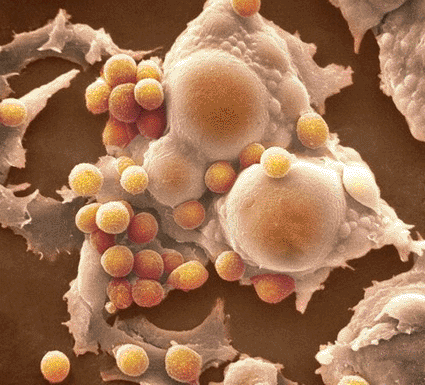Metabolic Pathway Engineered in Mice to Prevent Diet-Induced Obesity
By LabMedica International staff writers
Posted on 22 Jun 2009
While recent research advances and treatment methods have had little effect in reducing obesity levels, researchers may have discovered a completely new way to approach the problem. They successfully constructed a nonnative pathway in mice that increased fatty acid metabolism and resulted in resistance to diet-induced obesity.Posted on 22 Jun 2009
In recent years, obesity has taken on epidemic proportions in developed nations, contributing significantly to major medical problems, early death, and rising healthcare costs. According to the U.S. Centers for Disease Control and Prevention (Atlanta, GA, USA) estimates, at least one-quarter of all American adults and more than 15% of children and adolescents are obese.

Image: Colored scanning electron micrograph (SEM) of adipocytes surrounded by granulocytes (Photo courtesy of SPL).
"When we looked at the fatty-acid metabolism issue, we noted there are two aspects of the problem that needed to be addressed,” remarked Dr. James Liao, a chemical and biomolecular engineering professor from the University of California, Los Angeles (UCLA; USA). "One is the regulation; fatty acid metabolism is highly regulated. The other is digestion of the fatty acid; there needs to be a channel to burn this fat.”
The study's findings were published in the June 3, 2009, issue of the journal Cell Metabolism. "We came up with an unconventional idea which we borrowed from plants and bacteria,” said Dr. Jason Dean, a graduate student on Dr. Liao's team and an author of the study. "We know plants and bacteria digest fats differently from humans, from mammals. Plant seeds usually store a lot of fat. When they germinate, they convert the fat to sugar to grow. The reason they can digest fat this way is because they have a set of enzymes that is uniquely present in plants and bacteria. These enzymes are called the ‘glyoxylate shunt' and are missing in mammals.”
To examine the effects of the glyoxylate shunt on fatty acid metabolism in mammals, Dr. Liao's team cloned bacteria genes from Escherichia coli that would enable the shunt, and then introduced the cloned E. coli genes into the mitochondria of liver cells in mice; mitochondria are where fatty acids are burned in cells. The researchers discovered that the glyoxylate shunt blocked the energy-generating pathway of the cell in half, allowing the cell to digest the fatty acid much faster than normal. They also found that by cutting through this pathway, they created an additional pathway for converting fatty acid into carbon dioxide. This new cycle allowed the cell to digest fatty acid more effectively.
"The significance of this is great. It is a unique approach to understanding metabolism. Perturbing metabolic pathways, such as introducing the glyoxylate shunt and seeing how it affects overall metabolism, is a novel way to understand the control of metabolism,” stated associate professor of human genetics and pediatrics Dr. Katrina Dipple.
The investigators also found that the new pathway decreased the regulatory signal malonyl-CoA. When malonyl-CoA levels are high, a signal is released that tells the body it is too full and that it needs to stop using fat and begin making it. Malonyl-CoA is high after eating a meal, blocking fatty acid metabolism. The new pathway, however, allowed for fat degradation even when the body was full.
Ultimately, the research team found that mice with the glyoxylate shunt that were fed the same high-fat diet--60% of calories from fat--for six weeks remained skinny, compared with mice without the shunt. "One exciting aspect of this study is that it provides a proof-of-principle for how engineering a specific metabolic pathway in the liver can affect the whole body adiposity and response to a high-fat diet,” said Dr. Karen Reue, a UCLA professor of human genetics and an author of the study. "This could have relevance in understanding, and potentially treating, human obesity and associated diseases, such as diabetes and heart disease.”
"We are very hopeful,” said Dr. Liao. "This is the first example of how people can build new genes into mammals to achieve a desired function. It's very exciting that we've been able to achieve this new pathway in mammals that could potentially be used to fight a very serious problem.”
Related Links:
University of California, Los Angeles













